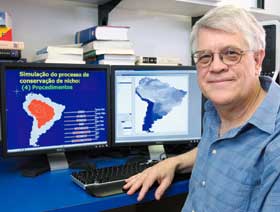  |
| HOME | THIS ISSUE | CALENDAR | GRANTS | BACK ISSUES | < BACK | NEXT > |
Geographical patterns of South American birds attract researchersby Scott Brinckerhoff - May 29, 2007 | ||||
| Tropical rainforests teem with plant and animal life, including birds, but dry and cold environments are much less hospitable, as any armchair naturalist knows. The question is “why?” Scientists, including Robert Colwell, a professor in UConn’s Department of Ecology and Evolutionary Biology, are not content merely to describe the phenomenon known as “species richness” – they want to understand its causes. In pursuit of this end, Colwell and a graduate student, Thiago Rangel, have dedicated years to the “spatial mapping” of species richness on a continental scale. The theories that have come out of their research have attracted both support and dissent in academia, along with significant grants. Using computer modeling, Colwell, Rangel, and their associates have undertaken the mapping of the known distribution of all 2,248 species of birds on the continent of South America, then reproduce the pattern. What they are learning has applications in species preservation, global climate studies, evolutionary theory, and biogeography. Their findings may help scientists predict what will happen to birds living in different locations on the planet, depending on trends in such environmental factors as elevation, topography, temperature, and rainfall. Their research is based around simulations that use existing data about where South America’s bird species are found, and in what richness or paucity of species. Colwell and Rangel are especially interested in species that have smaller geographical ranges. “We think it’s important to separate narrow-ranging species from wide-ranging ones,” Colwell says. “If we were working in the United States, for example, we wouldn’t pay as much attention to American robins, since they’re found almost everywhere. They’re like someone who gets to vote many times in an election. But Kirtland’s warbler is quite another story. “The narrow-ranging species are the ones we have to worry about,” he adds, “because there’s a greater risk that some unfortunate event will wipe out the species. We don’t have to worry about the robins.” As one might expect, computers are key to sorting through the data produced by 2,248 species of birds and at least a half dozen scientists on Colwell’s team. Based on what is known about where various species live, the scientists constructed algorithms that reduce the characteristics of those locales to numbers and symbols.
These are then used literally to paint colorful maps of South America that reflect the number of bird species living in one part of the continent or another. The computer models are used to predict what is actually occurring in the field. Factors, including random ones that the scientists view as supportive of species richness, are implicit in the maps that are then cross-checked with empirical data. Colwell uses an analogy to explain the work: “Suppose you were interested in where people ideally want to retire in the United States. Maybe the top factors are good medical care, cultural opportunities, warm weather, ocean breezes, and cheap housing. If you could find locations where various combinations of these factors converge, you could create a map and see a pattern. We’re doing something similar with the birds.” Colwell says the research is almost wholly dependent on computers, as controlled experiments would be impractical. “Unfortunately, carrying out planned, hands-on experiments with the biogeographical distribution of organisms is neither feasible nor ethical,” he says. The computer model simulates the geographical range of different species and reveals factors that seem to play a role in species richness. For example, topography was shown to be critical for narrow-ranging species, while climatic factors proved more important for wide-ranging species. In an article to appear in The American Naturalist, Rangel and Colwell and Brazilian colleague José Alexandre Diniz-Filho said the patterns of bird species richness are complex across South America. “Some regions, such as the Amazon Basin and the Atlantic Forest are highly species rich. ... Richness decreases toward higher latitudes.” Scientists differ over which factors are most important in determining species richness. Often, the differences focus on the role played by contemporary environment versus evolutionary history. Colwell and his colleagues tried to build computer models that give equal weight to both kinds of factors, as well as random processes. |
| ADVANCE HOME UCONN HOME |

